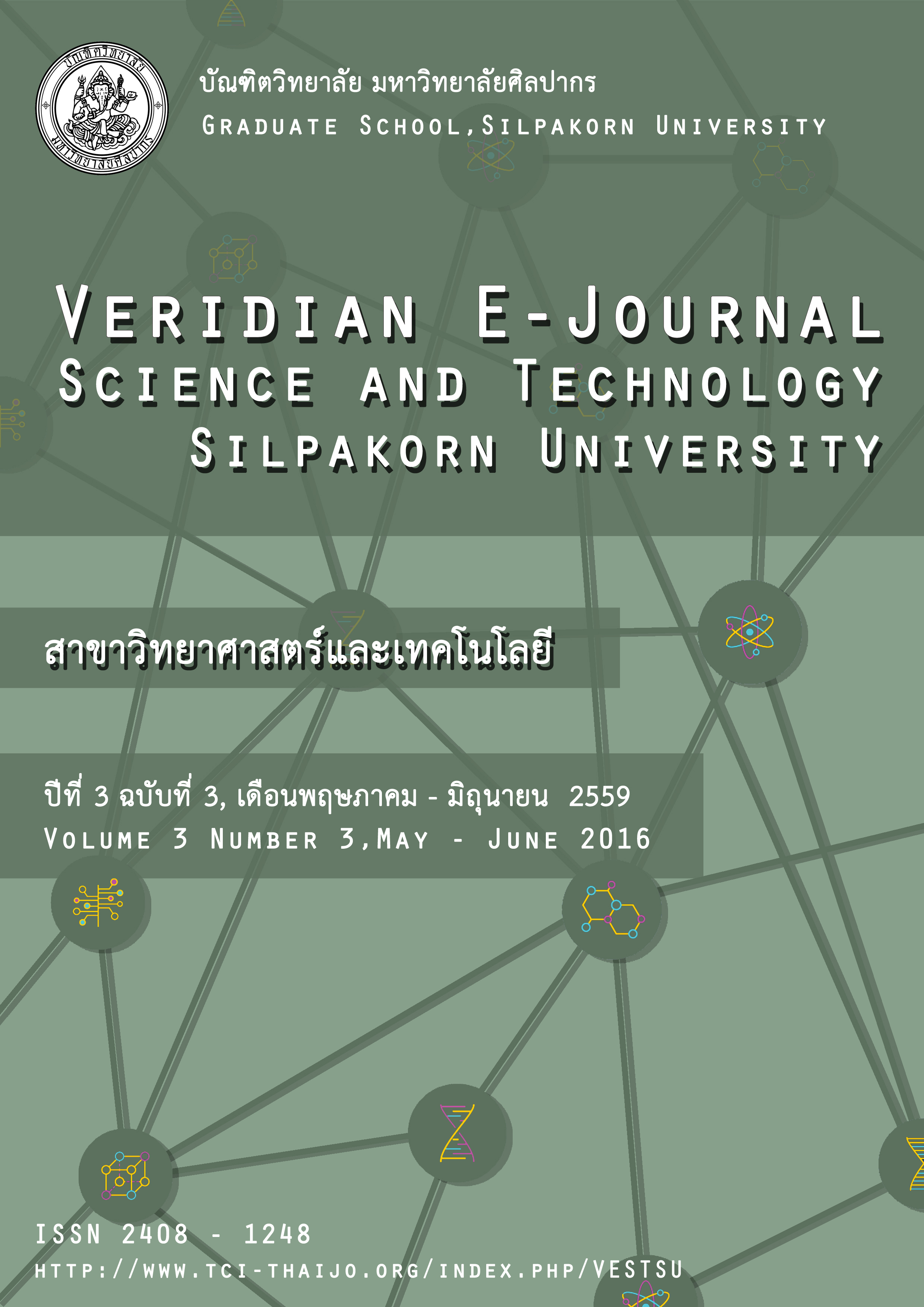การพัฒนาตัวแบบการพยากรณ์ผลผลิตมันสำปะหลังด้วยเทคนิคการทำเหมืองข้อมูล
Main Article Content
Abstract
การวิจัยครั้งนี้มีวัตถุประสงค์ 1) เพื่อพัฒนาตัวแบบการพยากรณ์ผลผลิตมันสำปะหลังด้วยเทคนิคการทำเหมืองข้อมูล 2) เพื่อพัฒนาระบบสารสนเทศการพยากรณ์ผลผลิตมันสำปะหลัง การสืบค้นข้อมูล และการประเมินความพึงพอใจของผู้ใช้งานระบบผ่านเว็บไซต์
โดยใช้ข้อมูลปัจจัยการผลิตมันสำปะหลังจากสำนักงานเกษตรจังหวัดกำแพงเพชร เพื่อสร้างตัวแบบพยากรณ์ โดยใช้เทคนิคการจำแหนกประเภทข้อมูล(Classification) ด้วยวิธีต้นไม้ตัดสินใจ (DecisionTree)
โดยจะใช้อัลกอริทึม จำนวน 5 ตัว ได้แก่ J48, RandomTree, SimpleCart, NaïveBayes, และLADTree แล้วทำการทดสอบตัวแบบการพยากรณ์ดัวยวิธี Cross-validation Test พบว่ายังให้ค่าแม่นยำเพียง 70.96% ซึ่งผู้วิจัยเห็นว่ายังไม่ดีพอ จึงได้ปรับปรุงวิธีการทดสอบโดยการแบ่งชุดข้อมูลออกเป็น 2 ส่วนได้แก่ ข้อมูลเรียนรู้ (Training Set)และข้อมูลทดสอบ (Test Set) จำนวน 5 ชุด แล้วทำการสร้างตัวแบบการพยากรณ์ด้วยอัลกอริทึม J48, RandomTree, SimpleCart, NaïveBayes และ LADTree อีกครั้งพบว่ามีค่าความแม่นยำสูงขึ้นกว่าวิธี Cross-validation Test ในทุกอัลกอริทึม ดังนั้นผู้วิจัยจึงเลือกตัวแบบการพยากรณ์ที่ให้ค่าความแม่นยำสูงสุด ในส่วนของข้อมูลทดสอบ (Test Set) อัลกอริทึม J48 ให้ค่าความแม่นยำสูงสุดที่ 75.64% อัลกอริทึม SimpleCart ให้ค่าความแม่นยำสูงสุดที่ 80.12% และอัลกอริทึม LADTree ให้ค่าความแม่นยำสูงสุดที่ 89.55% ส่วนอัลกอริทึม RandomTree และอัลกอริทึม Naïve Bayes ให้ค่าความแม่นยำต่ำกว่า 70% จึงไม่นำมาพิจารณา
จากนั้นนำอัลกอริทึมทั้งสามตัวที่ให้ค่าความแม่นยำสูงสุดไปพัฒนาตัวแบบการพยากรณ์ผลผลิตมันสำปะหลังด้วยเทคนิคการทำเหมืองข้อมูล ระบบสารสนเทศ และการสืบค้นข้อมูลในรูปแบบเว็บแอพพลิเคชั่น ซึ่งระบบสามารถสืบค้น ปรับปรุง เพิ่มเติม บันทึก และแสดงรายงานข้อมูลมันสำปะหลังได้ และผลการตอบแบบประเมินความพึงพอใจผ่านเว็บไซต์ของระบบสารสนเทศดังกล่าว จากเจ้าหน้าที่สำนักงานเกษตรจังหวัดกำแพงเพชร ผู้ใช้งานทั่วไป และผู้ดูแลระบบ รวมทั้งสิ้น 30 คน มีความพึงพอใจในการใช้งานระบบดังกล่าวเฉลี่ยที่ 91% ซึ่งถือว่าอยู่ในระดับที่ดีมาก
The objective of this research were 1) to development of model to predict the yield of cassava using data mining techniques, 2) to develop a forecast yield of cassava. With queries system to evaluate satisfaction of users of the system through the website.
The process on data from the Kamphaengphet Provincial Agriculture Extension Office. A predictive model was based on techniques Classification with a decision tree, using an algorithm of five, including the J48, RandomTree, SimpleCart, NaïveBayes, and LAD Tree. Then tested the predictive models provide a technicalCross-validation The result found that the accuracy was only 70.96%. Which was not good enough. Thevefove, testing methods had improved by splitting the series into two parts Including training set and 5 test set and then create predictive models. Using the folloning: Algorithm J48, SimpleCart, LADTree, Random Tree and Naïve Bayes again. The model obtained from Training set method were more accurate than from Cross-validation Test ins in all algorithms used, which were J48, RandomTree, SimpleCart, NaïveBayes, and LADTree Thus the selection of predictive models that provided the highest accuracy. In terms of Test Set, Algorithm J48 for maximum accuracy at 75.64%, SimpleCart with 80.12%, and LADTree with 89.55% while algorithms RandomTree and Naïve Bayes the accuracy lower than 70% were not taken into consideration.
Then only the first three models were used to implement the development of model to predict the yield of cassava. The model was integrated with the web-based information system for information search on cassava, which was designed and developed in this research to provide basic information such as update, add, and reports The for decision suppost respondents were rated their satisfaction over the site of such information. Officials of Kamphaengphet Provincial Agriculture Extension, users, and administrator a total of 30 people. There was satisfaction in the use of such systems by averaging the responses to a satisfaction rating of over 91%, which was considered very good.
